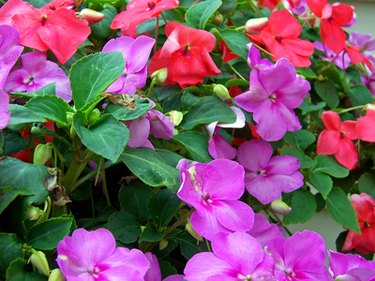
Easy to grow and available in a jaw-dropping array of colors, it is no surprise that impatiens (Impatien spp.) rank among the most popular bedding plants in the United States. Impatiens' cold tolerance is not very high, which is why these herbaceous perennials are often cultivated as annuals. Impatiens are winter hardy in U.S. Department of Agriculture plant hardiness zones 10 and 11. As long as you can provide adequate drainage, impatiens can be grown in containers or in garden beds.
Types of Impatiens
Video of the Day
Most impatiens sold as ornamentals in the U.S. fall into one of two groups: old-fashioned impatiens – which refers to the species Impatiens walleriana, native to Tanzania and Mozambique – and New Guinea impatiens (Impatiens hawkeri). Also known as busy lizzies, old-fashioned impatiens are typically 2 feet shorter or less, whereas New Guinea impatiens can grow up to 4 feet tall. The flowers of New Guinea impatiens are also larger as are the leaves, which are showier and more interesting.
Video of the Day
One key difference between the two types of impatiens is their light requirements. Impatiens walleriana is a shade-loving species, while New Guinea impatiens tolerate a bit more sunlight, though most need protection from full sun. Some New Guinea cultivars, however, have been hybridized to handle full sun as long as their high water needs are met. In addition, New Guinea impatiens also tend to be more resistant to downy mildew, a fungal disease that affects old-fashioned impatiens.
Impatiens Cultural Requirements

Impatiens need a lot of moisture, but it is also vital for the soil to drain well. If you're growing impatiens in a garden bed, water them when the top 2 inches of soil dry out. Container plants, including those in hanging baskets, need to be watered daily. If you are working with heavy clay soil, consider growing impatiens in a raised garden bed to improve drainage.
When planting impatiens outdoors, allow 8 to 12 inches of space between plants. The idea soil pH rage for both old-fashioned and New Guinea impatiens is 6.0 to 6.5. A general-purpose fertilizer is appropriate for impatiens. There is no need to deadhead impatiens, as it will not result in the plant reblooming.
Impatiens Minimum Temperature
When growing impatiens, weather conditions matter. As tropical plants, impatiens are very sensitive to the cold. Soil temperatures must reach 60 degrees before you can plant impatiens outdoors. In cold climates, you can start seeds inside. Both old-fashioned impatiens and New Guinea impatiens are tender perennials, which means that they do not survive frost.

In places where they are not winter hardy, impatiens are often grown as annuals. However, you can try to overwinter impatiens indoors. If you live in such a location, take cuttings from your favorite impatiens plants and bring these and any potted impatiens indoors before temperatures drop below 50 degrees Fahrenheit.
To successfully overwinter old-fashioned impatiens, you'll need to provide bright light but not direct sunlight and reduce the frequency of watering. New Guinea impatiens, on the other hand, enjoy full sun and regular watering when kept indoors.